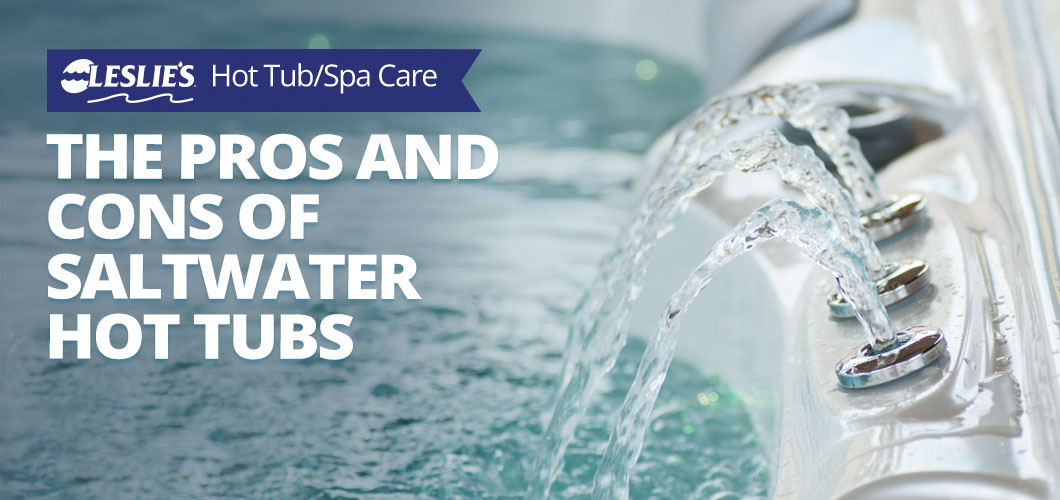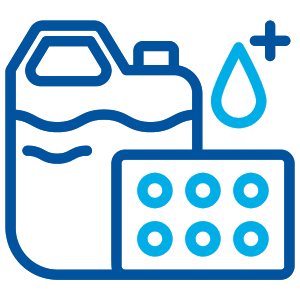
The Pros and Cons of Saltwater Hot Tubs
As hot tub owners seek more comfortable and low-maintenance options, saltwater hot tubs have gained popularity for their ability to offer a gentler soak and simplified chemical care. However, saltwater systems aren't without their unique maintenance needs and upfront costs. This article will dive into the pros and cons of a saltwater hot tub, along with an in-depth look at routine maintenance, chemical requirements, and the equipment needed to keep your spa running smoothly.
What is a Saltwater Hot Tub?
A saltwater hot tub uses a salt chlorinator system to produce chlorine from salt. The system relies on electrolysis to convert dissolved salt into chlorine, which sanitizes the water by breaking down bacteria and other contaminants. This process provides a more consistent level of sanitation and reduces the harshness often associated with traditional chlorine or bromine sanitizers.

The Pros of a Saltwater Hot Tub
1. Gentler on Skin and Eyes
One of the main advantages of a saltwater hot tub is the gentler feel of the water. The lower concentration of chlorine generated by the salt chlorinator means fewer harsh chemicals that can cause skin and eye irritation. Many users report softer, silkier water that feels more soothing during a soak.
2. Low Chemical Maintenance
With a saltwater chlorinator, the system continuously produces chlorine as needed, which means you don’t have to manually add chemicals as frequently. The constant, lower levels of chlorine reduce the need for shock treatments and chemical adjustments.
3. Softer Water
The salt in a saltwater hot tub gives the water a smoother, silkier feel. While it’s not as salty as seawater, the mild salinity can still provide a luxurious soaking experience compared to standard hot tub water.
4. Less Chemical Odor
Traditional chlorine-treated hot tubs often produce strong chemical odors due to chlorine byproducts called chloramines. In a saltwater system, the chloramines are minimized, resulting in sanitized, fresh-smelling water.
5. Fewer Additives
Saltwater systems can cut down on the amount of additional chemicals needed for maintenance, such as pH adjusters, algaecides, or clarifiers, especially when compared to traditional chlorine or bromine systems.

The Cons of a Saltwater Hot Tub
1. Higher Upfront Costs
A saltwater hot tub requires a salt chlorinator system, which can add significant upfront costs. While the long-term chemical savings may offset this over time, the initial investment can be a barrier for some hot tub owners.
2. Increased Corrosion Risk
Although the salt levels in a saltwater hot tub are relatively low, over time, salt can still be corrosive to certain components of your hot tub. This can affect metal parts, such as heaters, jets, and other internal fittings, potentially shortening the lifespan of your equipment.
3. Regular Equipment Maintenance
The salt chlorinator’s cell will need regular cleaning and eventual replacement. Calcium and mineral buildup can occur on the chlorinator cell, requiring you to clean it periodically to ensure it continues to work efficiently. Typically, the cell lasts 3-7 years, depending on use and water chemistry.
4. pH Levels Can Fluctuate
Saltwater hot tubs tend to experience upward drift in pH, which can lead to scaling or cloudy water if left unchecked. While saltwater systems are low-maintenance compared to traditional systems, it's still crucial to regularly test and adjust the pH level.
5. Power Usage
Salt chlorinators require a constant source of electricity to convert the salt into chlorine, which can add to your energy costs. While the overall increase is not dramatic, it's an important consideration, especially in energy-conscious households.
Routine Maintenance for a Saltwater Hot Tub
While saltwater hot tubs are known for being lower-maintenance than traditional chlorine or bromine systems, regular upkeep is still required. Here's what routine maintenance looks like for a saltwater hot tub:
Salt Level Monitoring
A saltwater hot tub generally requires a salt concentration of 1,750 to 3,000 parts per million (ppm), depending on the manufacturer’s recommendation. Too much or too little salt can cause the system to malfunction, so regular testing and adjustments are necessary.
Water Testing
While the salt chlorinator produces chlorine automatically, it's still important to test the chlorine levels, pH, and Total Alkalinity weekly. pH should be kept in the 7.2–7.8 range, and alkalinity between 80 and 120 ppm. This helps ensure balanced water and prevents scaling or corrosion.
Cleaning the Salt Cell
Over time, calcium deposits can build up on the chlorinator cell, reducing its efficiency. Most manufacturers recommend cleaning the cell every 3 to 4 months, depending on your water hardness. This can be done by using a cleaning stand or soaking the cell in a mild acid solution to dissolve any deposits.
Draining and Refilling
Just like traditional hot tubs, a saltwater hot tub needs to be drained and refilled periodically. Most experts recommend draining every 3 to 4 months, depending on use. The dissolved solids in the water can build up over time, even with regular filtration and chlorination.

Chemical Requirements for a Saltwater Hot Tub
A common misconception about saltwater hot tubs is that they don’t require any chemicals beyond salt. While the salt system helps automate chlorine production, you'll still need to manage water chemistry carefully. Here's what you’ll need:
pH and Alkalinity
As mentioned earlier, saltwater systems often cause pH to rise, so you'll need to use pH adjusters to maintain balanced water. Keeping alkalinity in check helps stabilize pH levels and prevents spikes or drops.
Calcium Hardness
Hard water can lead to calcium buildup on the hot tub’s surfaces and equipment, especially in a saltwater system. Calcium hardness should be maintained between 150–250 ppm to prevent scaling and protect your hot tub components.
Shock
Even though the chlorinator continuously produces chlorine, occasional shock treatments (using chlorine shock or non-chlorine shock) are still necessary to oxidize organic contaminants that accumulate in the water. Shocking the water every couple of weeks helps maintain water clarity and prevents the buildup of chloramines.

Equipment Needed for a Saltwater Hot Tub
To convert a traditional hot tub into a saltwater system, or if you're purchasing a new saltwater hot tub, you’ll need the following equipment:
Salt Chlorinator System
The salt chlorinator is the heart of the system. It converts the dissolved salt in the water into chlorine using electrolysis. Most systems include a control panel for adjusting chlorine output levels and monitoring system performance.
Titanium Salt Cell
The salt cell, typically made from titanium, is responsible for producing chlorine. Over time, this cell will wear out and need to be replaced (usually every 3–7 years, depending on use).
Saltwater-Compatible Filters
Because saltwater can be slightly more corrosive, it’s important to use high-quality filters designed for use in saltwater systems. Regular filter cleaning and replacement are essential to maintaining good water flow and sanitation.
A saltwater hot tub can offer a luxurious, low-maintenance soaking experience, with softer water and fewer harsh chemical additives. However, it also comes with higher upfront costs, potential equipment maintenance, and the need for regular pH monitoring. By weighing the pros and cons and understanding the maintenance and equipment requirements, you can decide if a saltwater system is the right choice for your hot tub.